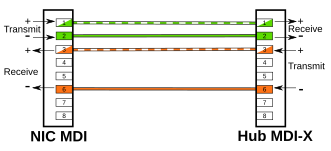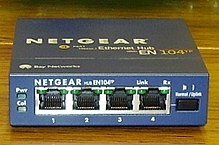Medium dependent interface

The medium-dependent interface ( English Medium Dependent Interface , abbr. MDI ) is in the information technology a part of the transmitter / receiver unit ( transceiver ) of a network device. It forms the mechanical connection between the physical interface ( PHY ) and the transport medium ( cable ).
In general, the term is used to denote the connection of a network card for the network cable - i.e. the network socket . The designation for the individual connections ( ports ) has established itself particularly in distribution devices ( hubs , switches ) .
MDI for twisted pair connections
With the introduction of 10BASE-T , network connections became common in which each device uses separate wires for sending and receiving. The network sockets (MDIs) must be connected in such a way that the transmission lines of one device are connected to the reception lines of the other.
When connecting two computers to one another with just one cable, it should be noted that common straight-through patch cables connect the transmit and receive lines of both computers and that communication is therefore not possible. It is therefore necessary to use a so-called crossover cable . These lines are interchanged (crossed) internally and communication is possible without additional devices.
A crossover cable must therefore always be used when two similar connections (computer and computer or also hub and switch) are connected to one another. In the much more common case of connecting two different connections (from the switch to the PC), normal straight-through patch cables are required.
- 1: 1 and crossover connections
MDI-X
A type of connection with a socket that is already crossed internally in the device is referred to as MDI-X . It is common for distribution devices (e.g. switch, hub). If such a socket is available, no crossover cable is required to connect an MDI device. If there is both an MDI and an MDI-X socket for the same port on the device (same number, corresponding markings), both sockets must never be used at the same time. Some switches or hubs also have an uplink port with which the MDI / MDI-X assignment can be switched.
Auto MDI-X
Newer 100 Mbit / s switches and network cards as well as practically all gigabit devices ( 1000BASE-T ) are capable of independently recognizing the transmission and receiving lines of the connected device and adapting to them. This is known as Auto MDI-X . The use of the cable type (crossed or uncrossed) does not matter.
See also
- Local Area Network
- Institute of Electrical and Electronics Engineers
- Auto- negotiation (auto-sensing)
swell
- ↑ IEEE 802.3-2012, 40.4.4 Automatic MDI / MDI-X Configuration



